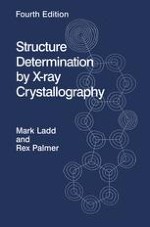2003 | Buch | 4. Auflage
Über dieses Buch
I was highly flattered when I was asked by Mark Ladd and Rex Palmer if I would write the Foreword to this Fourth Edition of their book. "Ladd & Palmer" is such a well-known and classic book on the subject of crystal structure determination, one of the standards in the field: I did feel daunted by the prospect, and wondered if I could do justice to it. The determination of crystal structures by X-ray crystallography has come a long way since the 1912 discoveries of von Laue and the Braggs. In the intervening years great advances have been made, so that today it is almost taken for granted that crystal structures can be determined in which hundreds, if not thousands, of sepa rate atomic positions can be found with apparent ease. In the early years the struc tures of relatively simple materials, such as the alkali halides, were often argued over and even disputed, whereas today we routinely see published structures of most complex molecular crystals, including the structures of viruses and proteins.
Anzeige
